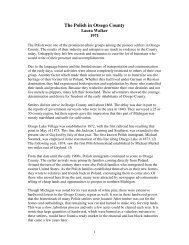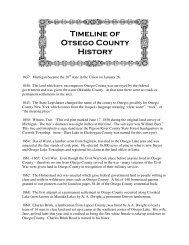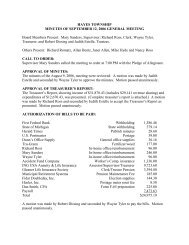Waters, Michigan - Otsego Community Connection
Waters, Michigan - Otsego Community Connection
Waters, Michigan - Otsego Community Connection
Create successful ePaper yourself
Turn your PDF publications into a flip-book with our unique Google optimized e-Paper software.
Three-peat: The Story of<br />
<strong>Waters</strong>, <strong>Michigan</strong><br />
Compiled by Phil Alexander<br />
Artwork on front and back covers by Carlene Lagrou<br />
Proceeds from this publication will go into the<br />
<strong>Otsego</strong> County Historical Society’s Endowment Fund<br />
© 2012 <strong>Otsego</strong> County Historical Society<br />
7/8/2012<br />
<strong>Waters</strong>,<br />
1<br />
<strong>Michigan</strong>
Table of Contents<br />
Introduction<br />
1. Early history and settlement<br />
2. The town’s 3 names: Bradford, Wrights Lake, <strong>Waters</strong><br />
3. Lumbering and Railroad history<br />
4. Henry Stephens – all three of them: Sr., Jr., and III (Tom)<br />
5. Baseball team<br />
6. The big barn and later Water’s Inn<br />
7. The famous bottle fence<br />
8. School (<strong>Otsego</strong> Lake Twp. District No. 2)<br />
9. Did you know? 1 st US Patent for snow machine (predecessor of today’s snowmobile)<br />
10. Remi and Edna Schotte<br />
11. Township Hall<br />
12. Fire Department<br />
13. Post Office<br />
14. Airport<br />
15. Ski Village<br />
16. Bradford Lake Association<br />
17. Water’s Business Group<br />
18. Weather Station<br />
19. Thunder Over <strong>Waters</strong><br />
Conclusion<br />
20. Timeline<br />
21. Bibliography<br />
7/8/2012 2
Three-peat: The Story of <strong>Waters</strong>, <strong>Michigan</strong><br />
Introduction<br />
Three-peat explores the fascinating history of <strong>Waters</strong>, <strong>Michigan</strong> and reveals how the town evolved<br />
through three boom and bust cycles. A drive through downtown <strong>Waters</strong> with its newly enhanced<br />
streetscape doesn’t immediately reveal its colorful past. You might not notice the former ski hill,<br />
airport, or site of the world famous bottle fence. The lumber mill is gone but remnants of the train<br />
trestle can be seen on Big Bradford Lake. Deep in the water lie sunken logs that for a while in the<br />
1950s were reclaimed and harvested for their unparallel size and beauty.<br />
The sounds from the town’s coronet band and the crowds cheering at a Sunday afternoon baseball<br />
game have long ago been silenced. The twice-a-day trains with their blasts of steam and earth<br />
shaking tremors announcing their arrival have been reduced to an occasional train now pulling only<br />
a few cars.<br />
One way to tell the story about <strong>Waters</strong> is to first find out what has already been said and written<br />
about the community. Authors Larry Wakefield and Roy Dodge featured <strong>Waters</strong> in their books<br />
about ghost towns in <strong>Michigan</strong>. Gene Scott included <strong>Waters</strong> in his book “<strong>Michigan</strong> Shadow Towns:<br />
A study of vanishing and vibrant villages.” Apparently he didn’t think <strong>Waters</strong> qualified as a ghost<br />
town. Local historian, Bill Granlund, has done an admirable job of writing articles about <strong>Waters</strong> in<br />
his newspaper column<br />
and subsequent book “A<br />
Step Back In Time”.<br />
These sources of<br />
background information<br />
plus many others which<br />
are listed in the<br />
bibliography combined<br />
with documents and<br />
photos from the <strong>Otsego</strong><br />
County Historical Society,<br />
<strong>Otsego</strong> County Library,<br />
and <strong>Otsego</strong> Lake<br />
Township were used to<br />
launch this publication.<br />
Many impromptu<br />
conversations and follow<br />
up interviews enriched the<br />
collection of reference<br />
materials. A treasure<br />
trove of information was found in the archived issues of the Gaylord Herald Times which recently<br />
were digitized and made available on-line with a searchable index.<br />
Sometimes discrepancies of dates or other facts were discovered. Some were simply typos and have<br />
been corrected. Others remain unresolved and are presented either in general terms such as the<br />
early 1870s instead of a specific date or the questionable information has been clearly noted.<br />
7/8/2012 3
Before we get to the history of <strong>Waters</strong>, let’s<br />
first discuss the geography. The community<br />
of <strong>Waters</strong>, <strong>Michigan</strong> is located in section 29<br />
of <strong>Otsego</strong> Lake Township in <strong>Otsego</strong><br />
County.<br />
Lat: 44.9° N<br />
Elev: 1263 ft<br />
Lon: 84.7° W<br />
Its main street is Old 27 which runs north<br />
and south. The road going east is Marlette<br />
and the road going west is Passenheim.<br />
Nearby towns include Frederic in Crawford<br />
County 8 miles to the south, and Gaylord<br />
17 miles to the north. <strong>Otsego</strong> Lake Village<br />
is 3 miles north of <strong>Waters</strong>.<br />
The town of <strong>Waters</strong> is surrounded by water:<br />
Little and Big Lakes as well as nearby Lake<br />
Marjory and Heart Lake. It is believed for<br />
this reason that the community received its<br />
name.<br />
How the town got its name<br />
General consensus is <strong>Waters</strong> was so named because it was surrounded by<br />
water. It is located between the following four lakes in southern <strong>Otsego</strong><br />
County near the Crawford County line.<br />
Little Bradford Lake is 21 acres in size with a maximum depth of 40 feet<br />
Big Bradford Lake is 244 acres in size with 225 acres in <strong>Otsego</strong> County and<br />
19 acres in Crawford County. At a maximum depth is 102 feet, Big Bradford Lake is<br />
among the deepest lakes in <strong>Otsego</strong> County.<br />
Lake Marjory is 40 acres in size with a maximum depth of 79 feet<br />
Heart Lake is 65 acres in size with a maximum depth of 117 feet.<br />
7/8/2012 4
Early history and settlement<br />
<strong>Waters</strong> is similar to many other small towns in northern <strong>Michigan</strong>. Its sole purpose was to support a<br />
lumber mill. The adage “Location, Location, Location” holds true. <strong>Waters</strong> was surrounded by a<br />
huge tract of highly desired white pine and was located on a lake that would supply water power<br />
necessary to run the steam engines that powered 19 th century lumber mills. In addition, the town was<br />
in line for a soon to be completed railroad that would transport the lumber to southern <strong>Michigan</strong> for<br />
further processing and distribution. Being a one company town was fine until the supply of trees<br />
was depleted. Once the lumber mill ceased operation, most residents had to move on to find<br />
employment elsewhere. Typical boom and bust cycle that created ghost towns throughout the<br />
region.<br />
However, <strong>Waters</strong> wasn’t destined to disappear from the map like many other former mill towns. It<br />
had a lot more living to do – thanks in part to Henry Stephens and later the Schotte family. Then<br />
there was the location factor again. This town was nestled between Big and Little Bradford Lakes<br />
which provided the natural resource that attracted resorters and tourists. U.S. 27 and later I-75<br />
would provide convenient transportation routes.<br />
7/8/2012 5
The town’s 3 names<br />
Bradford Lake, Wright’s Lake, <strong>Waters</strong><br />
Bradford Lake<br />
In the 1870s, what is now the town of <strong>Waters</strong> was named Bradford Lake. Resident historian, Fred<br />
White, revealed that “At <strong>Waters</strong>, there were a number of (lumbering) operations. The first was a<br />
fellow named Bradford … that’s why it was named Bradford Lake.” Who this Mr. Bradford was is a<br />
mystery. There weren’t any people with that last name found in the list of original homesteaders nor<br />
included in the 1880 census. Fred White further noted “they didn’t have any luck … so Wright<br />
bought out the Bradford holding.”<br />
Wright’s Lake<br />
In 1871, one of <strong>Michigan</strong>’s lumber barons, Ammi Wright of<br />
Saginaw, expanded his enterprise by establishing the firm of<br />
Wright, Wells, & Company with operations at Wright’s Lake<br />
in <strong>Otsego</strong> County. This wholly owned subsidiary was in<br />
partnership with Charles Wells, Charles Davis, and Reuben<br />
Kimball.<br />
In addition to the mill, the town of 75 people also had a<br />
general store and hotel. It is likely that the name Wrights or<br />
Wright’s Lake was only used by the company and for the<br />
railroad station. This would explain why the Post Office<br />
established in 1876 was designated Bradford Lake.<br />
The company operated on a large scale cutting white pine<br />
timber from adjacent tracts and sawing it into stock for the<br />
general trade. For 11 years this business operated with great<br />
success. The sawmill burned in 1881 with a loss of $14,000.<br />
In 1883, the firm reorganized and was named Wright & Davis.<br />
It moved on and sold its interest to Henry Stephens and Son.<br />
Ammi W. Wright<br />
<strong>Waters</strong><br />
When Henry Stephens bought out Wright & Davis’s operation at Bradford Lake, he “laid out a new<br />
town – <strong>Waters</strong> – at a distance from the mill” according to the August 27, 1886 Saginaw Daily Currier<br />
as noted in David McMacken’s book Built on Pines: The story of Ammi Willard Wright. This bit of<br />
information appears to show the origin of the town as we know it today. <strong>Waters</strong> is an<br />
unincorporated community – sometimes called a hamlet or town center. Unlike a village or city, it<br />
isn’t a separate unit of government and doesn’t have official city limits.<br />
7/8/2012 6
Stephen’s Lumber Company<br />
Stacks and stacks of<br />
sawn lumber air<br />
drying and waiting to<br />
be shipped by train<br />
to downstate<br />
markets<br />
One of the two mills<br />
produced 75,000<br />
board feet of pine<br />
and hemlock per day.<br />
Horses are used to haul logs<br />
from the forests to the train<br />
which will transport them to the<br />
sawmills in <strong>Waters</strong>. July 5, 2012<br />
The man to the far left with<br />
folded arms is James White.<br />
Stephens Lumber Company<br />
owned 27,000 acres of prime<br />
forests in southern <strong>Otsego</strong><br />
County.<br />
7/8/2012 7
<strong>Waters</strong> as remembered by James F. Allen<br />
One of the best and most quoted descriptions of <strong>Waters</strong> at the turn of the 20 th Century was told by<br />
James Allen. Here are excerpts from an undated written account as well as a taped interview<br />
conducted by Bill Granlund.<br />
Mr. Allen worked for Stephens Lumber Company in <strong>Waters</strong> from<br />
1899 to 1915. He was 18 years old and his brother also worked at<br />
the mill. His first job was repairing the trams at $1.75 per day and he<br />
worked 11hours per day from 6:00 a.m. to 6 p.m. with an hour off at<br />
noon for lunch. The following spring, he worked in the mill as a<br />
sawyer and was paid $4.00 per day which at the time was “good<br />
wages”. The work day was reduced to 10 hours.<br />
There were about 100 houses in <strong>Waters</strong> in the early 1900s and<br />
sidewalks were made of wood. Allen paid $3.75 a month to rent a<br />
small house. Two years later, when his daughter was born, the<br />
company added a bedroom and increased the rent by 50 cents. The<br />
house had a hand pump for indoor plumbing. There was a wood shed attached to the house that<br />
held 30 cords of wood for the cold winters.<br />
People made their own entertainment by holding events such as dances and card parities at the town<br />
hall. A medicine show would come to town in the summer. At Christmas, the company gave each<br />
family a turkey. Large families received two turkeys. For sports, there were baseball games and a<br />
tennis court. The baseball team would play on Sundays and then get together on the steps of the<br />
general store during the week to talk about the game. We had good time fishing for trout in the Au<br />
Sable River and Bradford and Red Head Lakes. There was good hunting for deer and rabbits, too.<br />
Mr. Allen recalls there were two doctors – Dr. O’Neil from Frederic and Dr. Ensly from Grayling –<br />
who provided good medical care to the people of <strong>Waters</strong>. He recalls a time when typhoid fever hit<br />
the community and when his daughter had pneumonia.<br />
Stephens Lumber Company had three mills at <strong>Waters</strong>: band, gang and planning. The band saw<br />
sawed pine in the summer and the gang saw sawed hemlock in the winter. Hardwood had to be<br />
sawn in the winter when the sap wasn’t running.<br />
The logs were brought in from the lake, sawed, edged, re-sawed, trimmed to length and sent up the<br />
tram to be loaded on railroad cars until the planning mill needed the lumber.<br />
Mr. Allen sawed most of the lumber for Tom Stephens barn (which later was the <strong>Waters</strong> Inn). He<br />
noted that Tom’s father, Henry Stephens, Jr. was a wonderful man who could come up from<br />
Detroit, spend a week in the summer, and would get out with the men, sit on the steps of the<br />
company office and talk to the men. Mr. Allen concludes by saying, “Working at Stephens Lumber<br />
Company was about the best part of my life.”<br />
The next five pages are photos with written comments by James F. Allen<br />
7/8/2012 8
<strong>Waters</strong> as remembered by James F. Allen - continued<br />
This is Stephens Lumber Company office in about 1905 where tallies of lumber from the band mill,<br />
planning mill, gang mill and lumber yard were kept track of, orders for shipment and all the payrolls<br />
were made up. Back of this office you can see the planning mill and straight across the street facing<br />
west there was a general store selling most everything one needed.<br />
The<br />
Company<br />
issued $5<br />
and $10<br />
checks<br />
with<br />
markings<br />
from 5<br />
cents to<br />
25 cents.<br />
The store<br />
would<br />
punch out<br />
what ever<br />
your<br />
purchase<br />
amounted<br />
to.<br />
7/8/2012 9
<strong>Waters</strong> as remembered by James F. Allen - continued<br />
This is a picture of the band mill consisting of the band and re-saw that I sawed on for 12 years. In<br />
the summer, we cut white pine. 55 to 60,000 feet of white pine every 10 hours. In the winter we cut<br />
all kinds of hardwood in the winter. Lots of sand and dirt required changing saws about 13 times a<br />
day. We cut 30,000 feet of frozen hardwood logs every 10 hours. This mill was located farthest<br />
south of town.<br />
This is another view of the band mill taken from the east end of the mill level with tramway.<br />
Picture of the crew foreman, sawyer, filer, log jacker, engineer, fireman, trimmerman, edgerman, slab<br />
cutters, lath mill men, and lumber runners. To the right, you can see load of lath made of white<br />
pine. At left you can see rail cars and track where lumber is loaded on these cars and run or pushed<br />
into the yard at various points and piled for air drying.<br />
7/8/2012 10







